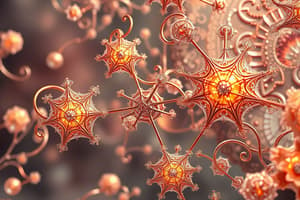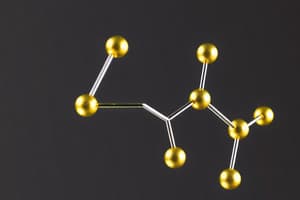Podcast
Questions and Answers
What is the co-ordination number of the complex [Ag(NH3)2]+?
What is the co-ordination number of the complex [Ag(NH3)2]+?
- 1
- 6
- 2 (correct)
- 4
All ligands must be negatively charged in order to bond with metal ions.
All ligands must be negatively charged in order to bond with metal ions.
False (B)
Define a ligand.
Define a ligand.
A particle with a lone pair of electrons that bonds to metals by a co-ordinate bond.
The complex ion [CuCl4]2- has a co-ordination number of ______.
The complex ion [CuCl4]2- has a co-ordination number of ______.
Match the following complexes with their shapes:
Match the following complexes with their shapes:
Which of the following ligands is a bidentate ligand?
Which of the following ligands is a bidentate ligand?
Haemoglobin binds oxygen more strongly than carbon monoxide.
Haemoglobin binds oxygen more strongly than carbon monoxide.
What is the coordination number of the complex [Cu(EDTA)]2-?
What is the coordination number of the complex [Cu(EDTA)]2-?
The ligand _________ forms four bonds in a complex with iron in haemoglobin.
The ligand _________ forms four bonds in a complex with iron in haemoglobin.
Match the following ligands with their types:
Match the following ligands with their types:
Which complex represents a coordination sphere involving a unidentate ligand?
Which complex represents a coordination sphere involving a unidentate ligand?
Cyanide ions will bond to haemoglobin in preference to oxygen.
Cyanide ions will bond to haemoglobin in preference to oxygen.
What is the oxidation state of chromium in the complex [Cr(NH3)6]3+?
What is the oxidation state of chromium in the complex [Cr(NH3)6]3+?
Flashcards
Ligand
Ligand
Particle with lone pair that bonds to metals via a co-ordinate bond.
Complex
Complex
Metal ion combined with co-ordinately bonded ligands.
Co-ordination number
Co-ordination number
Number of co-ordinate bonds from ligands to a metal ion.
Lewis base
Lewis base
Signup and view all the flashcards
Lewis acid
Lewis acid
Signup and view all the flashcards
Unidentate ligands
Unidentate ligands
Signup and view all the flashcards
Examples of Unidentate ligands
Examples of Unidentate ligands
Signup and view all the flashcards
Bidentate ligands
Bidentate ligands
Signup and view all the flashcards
Examples of Bidentate ligands
Examples of Bidentate ligands
Signup and view all the flashcards
Multidentate ligands
Multidentate ligands
Signup and view all the flashcards
Example of Multidentate ligand
Example of Multidentate ligand
Signup and view all the flashcards
Haemoglobin
Haemoglobin
Signup and view all the flashcards
Toxicity of CO and CN-
Toxicity of CO and CN-
Signup and view all the flashcards
Study Notes
Complex Ions Definitions
- Ligand: A particle with lone pairs of electrons that bonds to a metal ion via a coordinate bond.
- Complex: A metal ion with co-ordinately bonded ligands.
- Coordination number: The number of coordinate bonds from ligands to a metal ion.
- Lewis base: A lone pair donor.
- Lewis acid: A lone pair acceptor.
Complex Ion Formation
- Common ligands include H₂O, NH₃, and Cl⁻ ions, which have lone pairs of electrons.
- Complexes form when ligands use their lone pairs to form coordinate bonds with a metal ion.
- In the example of [CuCl₄]²⁻, four chloride ions act as ligands, each donating a lone pair to the Cu²⁺ ion.
- Ligands act as Lewis bases because they donate lone pairs to transition metals to form coordinate bonds.
- The metal ion acts as a Lewis acid because it accepts lone pairs.
Shapes of Complexes
- Common shapes include linear (2), square planar (4), tetrahedral (4), and octahedral (6).
- Coordination number reflects the number of ligands surrounding the metal ion.
- Linear complexes (e.g., [Ag(NH₃)₂]⁺) are common with Ag⁺ ions, while square planar complexes (e.g., [PtCl₄]²⁻) are common with Pt²⁺ and Ni²⁺ and when ligands are too big for 6 to fit.
- Tetrahedral complexes (e.g., [CuCl₄]²⁻) are common with small ligands (e.g., H₂O, NH₃).
- Octahedral complexes (e.g., [Cu(H₂O)₆]²⁺) are also common with small ligands.
Types of Ligands
- Unidentate ligands: Form one coordinate bond to a metal ion (e.g., Cl⁻, OH⁻, CN⁻, H₂O, NH₃).
- Bidentate ligands: Form two coordinate bonds to a metal ion (e.g., 1,2-diaminoethane, ethanedioate ion (C₂O₄²⁻)).
- Multidentate ligands: Form more than two coordinate bonds to a metal ion (e.g., EDTA⁴⁻, porphyrin).
- EDTA⁴⁻ can form 6 bonds.
- Porphyrin can form 4 bonds.
Haemoglobin
- Haemoglobin is a protein containing four iron(II) (Fe²⁺) centres, each with a porphyrin ligand.
- One of the coordination sites in the Haemoglobin is available to bind oxygen.
- Oxygen is transported in blood bound to iron in haemoglobin.
- Cyanide ions (CN⁻) and carbon monoxide (CO) are better ligands than oxygen (O₂), so they bind to haemoglobin in preference to oxygen, preventing oxygen transfer.
Studying That Suits You
Use AI to generate personalized quizzes and flashcards to suit your learning preferences.




